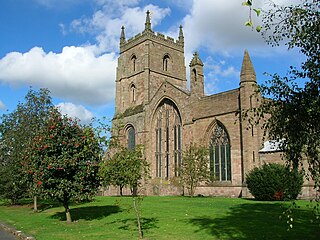Related Research Articles

Dore Abbey is a former Cistercian abbey in the village of Abbey Dore in the Golden Valley, Herefordshire, England. A large part of the original medieval building has been used since the 16th century as the parish church, with remaining parts either now ruined or no longer extant.

Alvecote Priory is a ruined Benedictine Priory in Alvecote, Warwickshire, England. The site has been scheduled as an ancient monument. Now very little remains of the priory, most of the walls have been eroded but a fairly high wall remains on one side. The main entrance arch is the most impressive feature, still standing at around 20 feet (6.1 m) high. The attached dovecote also survives, however both the ruined priory and dovecot are on the Heritage at Risk Register due to vandalism and water damage.

Avenbury is a civil parish in Herefordshire, England. It is on the A465, just south of Bromyard, and by the River Frome. The population of this parish at the 2011 Census was 225.

Walter de Lacy was lord of Meath in Ireland. He was also a substantial land owner in Weobley, Herefordshire, in Ludlow, Shropshire, in Ewyas Lacy in the Welsh Marches, and several lands in Normandy. He was the eldest son of Hugh de Lacy, a leading Cambro-Norman baron in the Norman invasion of Ireland, and Rohese of Monmouth.

The Priory Church is an Anglican parish church in Leominster, Herefordshire, England, dedicated to Saint Peter and Saint Paul. The building was constructed for a Benedictine Priory in about the 13th century, although there had been an Anglo-Saxon monastery in Leominster, possibly on the same site. In 1539 the east end of the church was destroyed along with most of the monastic buildings, but the main body of the church was preserved.
Holme Lacy is a village in the English county of Herefordshire. The population of the civil parish was 466 at the 2011 Census.

Llanthony Secunda Priory was a house of Augustinian canons in the parish of Hempsted, Gloucestershire, England, situated about 1/2 a mile south-west of Gloucester Castle in the City of Gloucester. It was founded in 1136 by Miles de Gloucester, 1st Earl of Hereford, a great magnate based in the west of England and the Welsh Marches, hereditary Constable of England and Sheriff of Gloucestershire, as a secondary house and refuge for the canons of Llanthony Priory in the Vale of Ewyas, within his Lordship of Brecknock in what is now Monmouthshire, Wales. The surviving remains of the Priory were designated as Grade I listed in 1952 and the wider site is a scheduled ancient monument. In 2013 the Llanthony Secunda Priory Trust received funds for restoration work which was completed in August 2018 when it re-opened to the public.

Ewyas Harold is a village and civil parish in the Golden Valley in Herefordshire, England, near the Wales-England border about halfway between Abergavenny, Monmouthshire, and Hereford. The population of this civil parish at the 2011 census was 883. It lies on the Dulas brook, and is contiguous with the neighbouring village of Pontrilas.
Ewyas was a possible early Welsh kingdom which may have been formed around the time of the Roman withdrawal from Britain in the 5th century. The name was later used for a much smaller commote or administrative sub-division, which covered the area of the modern Vale of Ewyas and a larger area to the east including the villages of Ewyas Harold and Ewyas Lacy.
Clifford Priory was a priory in Herefordshire, England at grid reference SO2531944576.

Flanesford Priory was an Augustinian priory in Herefordshire, England.
Saint Guthlac's Priory was a Benedictine priory in Hereford, England. It was originally founded in the early 12th century near the Church of St. Guthlac in town. After the church was ruined circa 1143, during the Anarchy, it relocated to a site between the present day Bath Street and Commercial Road at grid reference SO51534019.
Limebrook Priory was a priory in Lingen, Herefordshire, England at grid reference SO37386604.
Titley Priory was a priory near Titley in Herefordshire, England at grid reference SO32966011.

Deeping St James Priory was a priory in Deeping St James, Lincolnshire, England. In 1139 Baldwin Fitz Gilbert established the Benedictine Priory of Saint James at Deeping as a cell of Thorney Abbey. The cell was dissolved at the surrender of Thorney in 1539. The priory church remains as the Church of England parish church of Deeping St James and is a Grade I listed building.

Walterstone is a village and civil parish in Herefordshire, England, near the Welsh border and the Brecon Beacons National Park, 14 miles (23 km) south-west of Hereford. The parish had a population of 97 in the 2001 UK Census and is grouped with Craswall, Llanveynoe and Longtown to form Longtown Group Parish Council for administrative purposes.
Clodock Welsh: Clydog is a village in the west of Herefordshire, England. It lies on the River Monnow in the foothills of the Black Mountains, close to the border with Wales. The village is in the civil parish of Longtown.
Ewyas Lacy was an ancient hundred in southwest Herefordshire. It was part of the ancient Welsh region of Ewyas claimed by the de Lacy family following the Norman Conquest. It equated to the modern civil parishes of Craswall, Cusop, Llancillo, Llanveynoe, Longtown, Michaelchurch Escley, Newton, Rowlestone, St Margarets, and Walterstone.

Pencombe with Grendon Warren is a civil parish in the county of Herefordshire, England. The parish was created in 1895 from the parishes of Pencombe and Grendon Warren, its only nucleated settlement being the village of Pencombe.
References
- ↑ "Craswall Priory". Herefordshire Through Time. Herefordshire Council. Archived from the original on 2011-06-09. Retrieved 2010-09-19.
- ↑ Heritage at Risk Register 2018, West Midlands (Report). Historic England. p. 1. Retrieved 29 December 2018.

